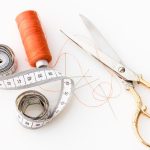If you're shopping for a budget-friendly serger for fabrics, finding the right one can feel like searching for a needle in a haystack. But fear not! We've sifted through the options to bring you the top contender for your sewing needs.
In this guide, we'll explore the key features and capabilities you should look for in a budget-friendly serger, so you can make an informed decision. Whether you're a seasoned seamstress or a novice crafter, understanding the best serger for your fabric projects is crucial.
So, let's unravel the mystery and discover the perfect budget-friendly serger that meets your stitching requirements without breaking the bank.
Key Takeaways
- Prioritize stitch quality and speed when choosing a budget-friendly serger for fabrics.
- Look for a serger with adjustable stitch length and differential feed to ensure versatility.
- Consider a serger with a built-in thread cutter for convenience and time-saving benefits.
- Research different brands and models known for affordability, comparing features, build quality, and price range before making a decision.
Understanding Your Serger Needs
First, assess your specific sewing requirements to determine the essential features your serger needs. Consider the types of projects you'll be working on and the fabrics you'll use. This will help you determine the number of threads and the type of stitches your serger should have. Additionally, think about your skill level and the features that will support your sewing proficiency.
Serger maintenance is crucial for the longevity and performance of your machine. Regular cleaning, oiling, and changing of needles and blades are essential for smooth operation. Understanding the maintenance needs of your serger will ensure that it continues to function at its best.
In addition to maintenance, familiarize yourself with serger troubleshooting. Knowing how to identify and resolve common issues such as thread tension problems, skipped stitches, or stitching irregularities will save you time and frustration. Learning how to troubleshoot will also help you make informed decisions when choosing a serger that's easy to maintain and troubleshoot.
Top Features to Look For
When looking for a budget-friendly serger, it's important to consider the stitch quality and speed as top features.
A serger with adjustable stitch length and differential feed can give you the flexibility to work with different types of fabrics.
Additionally, a built-in thread cutter can save you time and hassle during your sewing projects.
Stitch Quality and Speed
You'll want to prioritize consistent stitching and fast speeds when selecting a budget-friendly serger for fabrics. Here are the top features to look for:
- Stitch Tension Control: Ensure the serger provides easy adjustment of stitch tension for different fabric types, allowing you to achieve professional-looking seams.
- Differential Feed: Look for a serger with adjustable feed ratios to prevent stretching or puckering of fabrics, especially useful when working with knits and lightweight materials.
- Noise Level: Consider a serger with a quiet operation, especially if you plan to use it in a home setting where noise can be a concern.
- Portability: Opt for a lightweight and compact serger that's easy to move and store, making it convenient for sewing on the go or in a small workspace.
Built-In Thread Cutter
To ensure efficient operation and convenience in your budget-friendly serger, consider a model with a built-in thread cutter. This feature streamlines the sewing process and enhances workflow.
A built-in thread cutter allows you to quickly and easily trim thread tails as you sew, saving time and effort. It eliminates the need for handheld scissors or separate thread snips, making the sewing process more seamless.
When evaluating sergers, look for models with a high-quality built-in thread cutter that cleanly cuts both chain and thread. This feature ensures clean cuts and eliminates the hassle of using additional tools.
Additionally, some sergers have advanced threading techniques that work in conjunction with the built-in thread cutter. These techniques simplify the threading process and reduce the likelihood of tangles or errors.
Prioritize a serger with a reliable built-in thread cutter to optimize your sewing experience. It will make your sewing process more efficient and convenient, allowing you to focus on your project rather than worrying about thread trimming.
Budget-Friendly Serger Options
For finding budget-friendly serger options, start by researching various brands and models known for their affordability and quality. Consider the following factors to make an informed decision:
- Brand Comparison and Price Range: Look into different brands that offer sergers at budget-friendly prices. Compare the features, build quality, and price range of sergers from reputable brands like Brother, Janome, Singer, and Juki. Each brand may offer varying price points and features, so it's essential to weigh your options carefully.
- Customer Reviews: Before making a purchase, delve into customer reviews for the sergers you're interested in. Real-life experiences from other users can provide valuable insights into the performance, durability, and overall satisfaction with a particular serger model. Pay attention to reviews that highlight the affordability and reliability of the serger.
- Warranty Options: Explore the warranty options offered by different brands. A good warranty can provide peace of mind and protection against any potential defects or issues that may arise with your budget-friendly serger.
- Additional Accessories and Features: Some budget-friendly sergers may come with extra accessories or unique features that add value to your purchase. Consider the included accessories, such as presser feet or extra needles, and any special features that enhance the serger's functionality.
Comparison of Stitching Capabilities
When comparing stitching capabilities, it's important to consider the range of stitch types available on each serger. Assessing the fabric compatibility of different serger models is also crucial in determining which one best suits your needs.
Understanding the stitching capabilities will help you make an informed decision based on your specific sewing projects and preferences.
Stitch Types Comparison
Looking to compare stitch types for various sergers? When considering the stitching capabilities of different sergers, it's essential to pay attention to specific features that can affect the quality and versatility of your stitches.
Here are some key factors to consider:
- Stitch Length: Different sergers offer varying options for stitch length, allowing you to adjust the length of the stitches based on your fabric and project requirements.
- Tension Adjustment: The ability to adjust the tension settings on a serger is crucial for achieving balanced and professional-looking stitches across different types of fabrics.
- Built-in Stitch Types: Evaluate the range of built-in stitch types available on the serger, such as overlock, rolled hems, flatlock, and decorative stitches.
- Ability to Create Custom Stitches: Some sergers offer the flexibility to create custom stitches, providing you with more creative control over your sewing projects.
Fabric Compatibility Assessment
Assess the compatibility of various fabrics with the stitching capabilities of different sergers. When comparing sergers for fabric compatibility, consider the machine's ability to handle different fabric thicknesses. Look for a serger with adjustable tension control to ensure optimal stitching results on various fabric types.
Some budget-friendly sergers may struggle with heavier fabrics, so it's important to test the machine with different fabric weights to assess its performance. Additionally, examine the serger's stitch options and settings to determine its suitability for different fabric types.
Threading and Setup Simplified
Setting up the serger for threading is straightforward and can be done in just a few simple steps. Follow these tips to simplify the threading process and troubleshoot any issues that may arise:
- Clear Workspace: Ensure you have a well-lit and clutter-free workspace to make threading easier. A clear area allows you to focus and prevents small parts from getting lost.
- Threading Order: Always follow the threading order specified in the user manual. Typically, it involves threading the upper looper, lower looper, right needle, and left needle in that order. Following the correct sequence is crucial for proper stitching.
- Tension Adjustment: Understand how to adjust the tension settings for different fabrics. Start with the tension dials set to the recommended standard settings for the fabric you're using and make adjustments as needed.
- Thread Quality: Invest in good quality threads to prevent breakage and ensure smooth stitching. Low-quality threads can cause frustration and may not produce the best results.
Versatility in Fabric Handling
Achieving versatility in fabric handling is essential for maximizing the potential of your budget-friendly serger. When selecting a serger, consider the range of fabric types it can handle. A good serger should be able to work with a variety of fabrics such as cotton, knits, fleece, and even delicate fabrics like silk.
The ability to adjust thread tension is also crucial for versatility. Different fabrics require different thread tensions to prevent puckering or stretching. A budget-friendly serger with easily adjustable thread tension settings will allow you to work with various fabric types without compromising the quality of the finished seams.
Look for a serger that offers clear and user-friendly controls for adjusting thread tension, making it easier for you to achieve professional results across a wide range of fabrics.
Durability and Long-Term Value
When selecting a budget-friendly serger, consider the durability and long-term value it offers, ensuring that it can withstand extensive use across a variety of fabric types. A durability assessment is crucial in determining the longevity of the serger and its ability to handle different fabrics. Look for cost-effective options that provide durability without sacrificing quality.
Here are four key factors to consider when assessing the durability and long-term value of a budget-friendly serger:
- Construction: Examine the materials used in the construction of the serger. Metal components tend to be more durable than plastic ones, providing sturdiness and longevity.
- Motor Power: A robust motor is essential for handling heavy-duty fabrics, frequent use, and prolonged sewing sessions. Look for a serger with a motor that can withstand extended periods of operation.
- Stitch Quality: Assess the overall stitch quality and consistency produced by the serger. A well-built serger should deliver precise and reliable stitches across various fabric types.
- Brand Reputation: Research the reputation of the brand and read reviews from other users to gauge the long-term value and reliability of the serger. A reputable brand often indicates a higher level of durability and customer satisfaction.
User-Friendly Controls and Functions
With user-friendly controls and functions, navigating and operating a budget-friendly serger becomes effortless, making your sewing experience more efficient and enjoyable. User-friendly design is crucial for a serger to be accessible to sewers of all skill levels. When selecting a budget-friendly serger, look for intuitive controls that are easy to understand and adjust. This will allow you to focus on your creativity rather than struggling with complicated settings.
| Features | Benefits |
|---|---|
| Color-Coded Threading | Simplifies the threading process, saving time and frustration |
| Adjustable Stitch Length and Width | Provides versatility for different fabrics and projects |
| Differential Feed | Ensures stitch precision and prevents stretching or puckering of fabric |
Having color-coded threading makes re-threading your serger a breeze, saving you time and reducing frustration. Additionally, the ability to adjust stitch length and width offers you the flexibility to work with various fabric types. Lastly, a differential feed function guarantees stitch precision, preventing fabric distortion. These user-friendly controls and functions will greatly enhance your serging experience, allowing you to focus on your creative projects.
Frequently Asked Questions
Can a Budget-Friendly Serger Handle Thick or Heavy Fabrics Like Denim or Canvas?
Yes, a budget-friendly serger can handle thick or heavy fabrics like denim or canvas. It's important to check needle options, thread tension, and differential feed. Adjusting stitch width can also help achieve optimal results.
Are There Any Special Maintenance Requirements for a Budget-Friendly Serger to Ensure Long-Term Durability?
To maintain long-term durability, ensure you regularly clean, oil, and adjust the tension and threading of your budget-friendly serger. These special maintenance requirements will keep your serger in top condition for years to come.
Can a Budget-Friendly Serger Handle Decorative Stitching or Only Basic Seams and Edges?
Yes, a budget-friendly serger can handle decorative stitching in addition to basic seams and edges. It also offers fabric versatility, making it suitable for various types of materials. Regular maintenance and proper use will ensure long-term durability.
How Easy Is It to Find Replacement Parts or Accessories for a Budget-Friendly Serger?
You'll find replacement parts and accessories easily for a budget-friendly serger, ensuring cost-effective maintenance and long-term durability. Availability of these items is crucial for keeping your machine in top condition.
Are There Any Specific Fabric Types or Blends That a Budget-Friendly Serger May Struggle to Handle?
Certain fabric types or blends may pose challenges for a budget-friendly serger. Fabrics like delicate silk or thick denim may cause struggling. Recommended alternatives include using a sewing machine with a zigzag stitch or adjusting the serger settings carefully.
- How to Find Coconut Fabric by the Yard for Sewing Projects - June 29, 2025
- Coconut Fabric for Erosion Control: A Sustainable Solution - June 29, 2025
- What Is Crypton Coconut Fabric? a Guide to Performance Textiles - June 29, 2025







